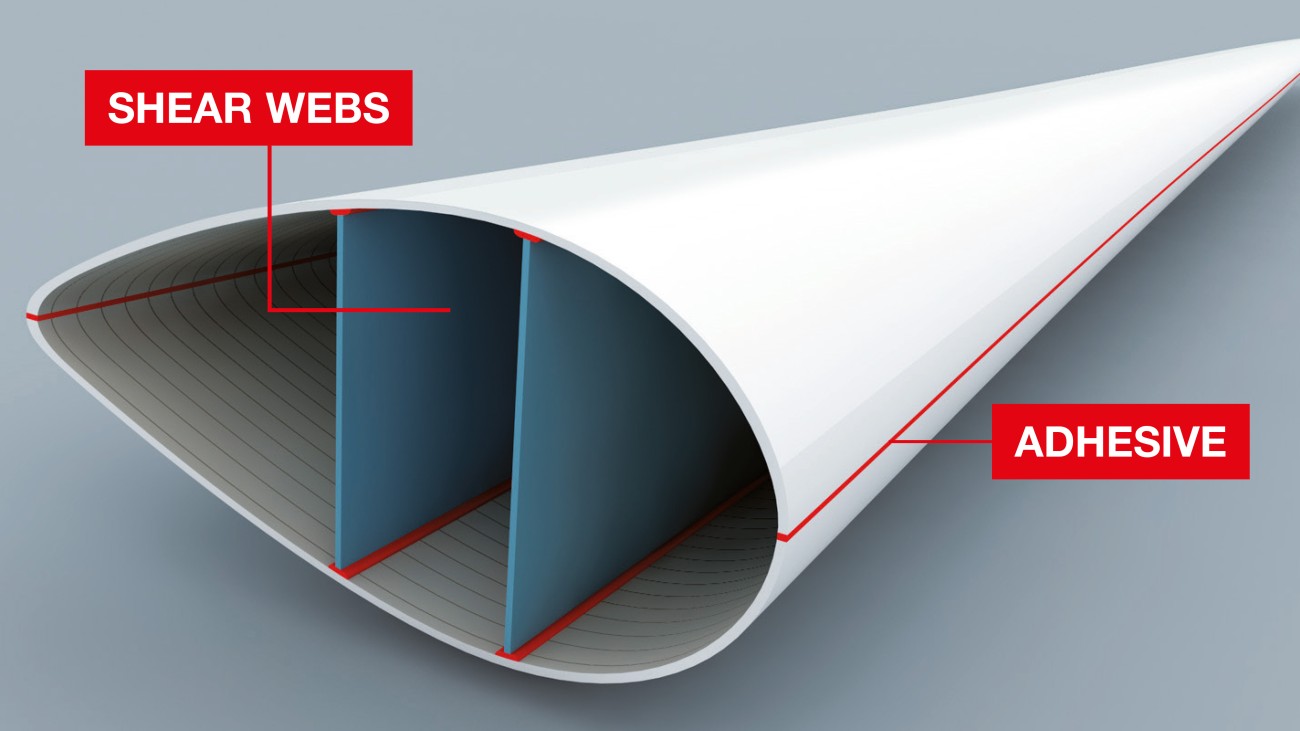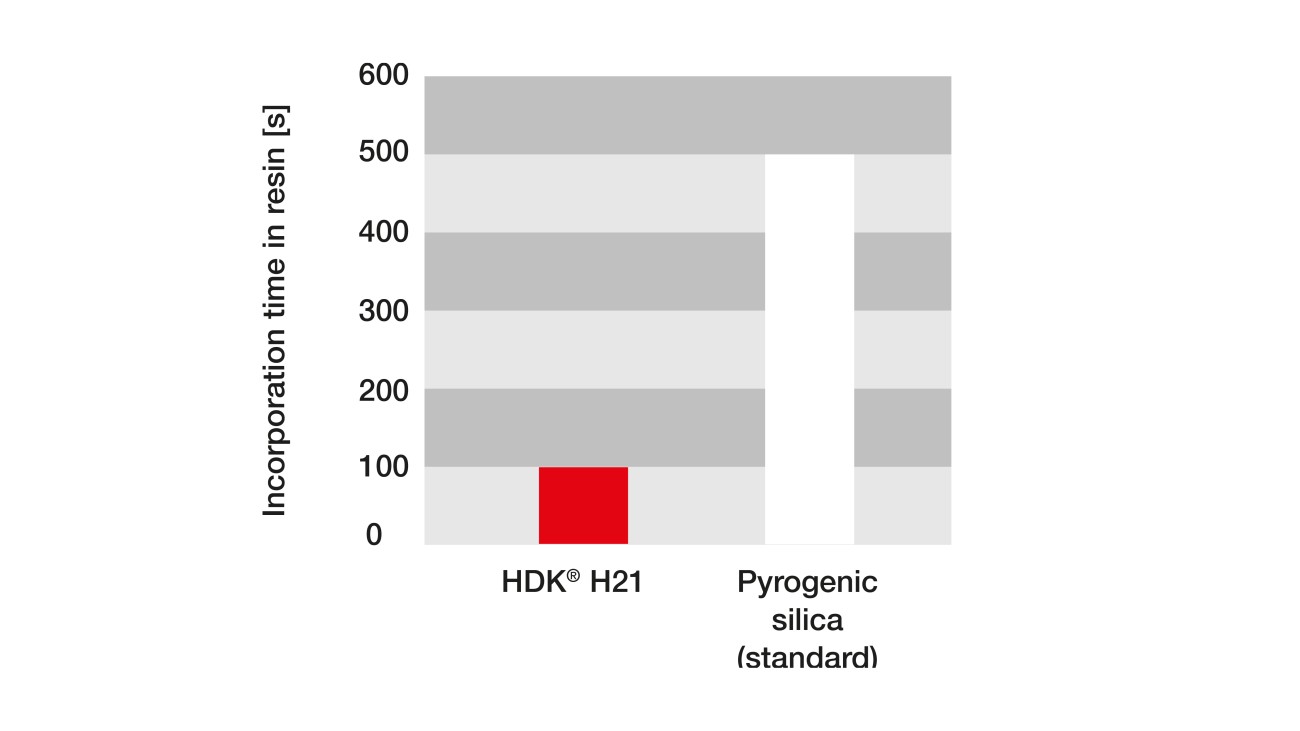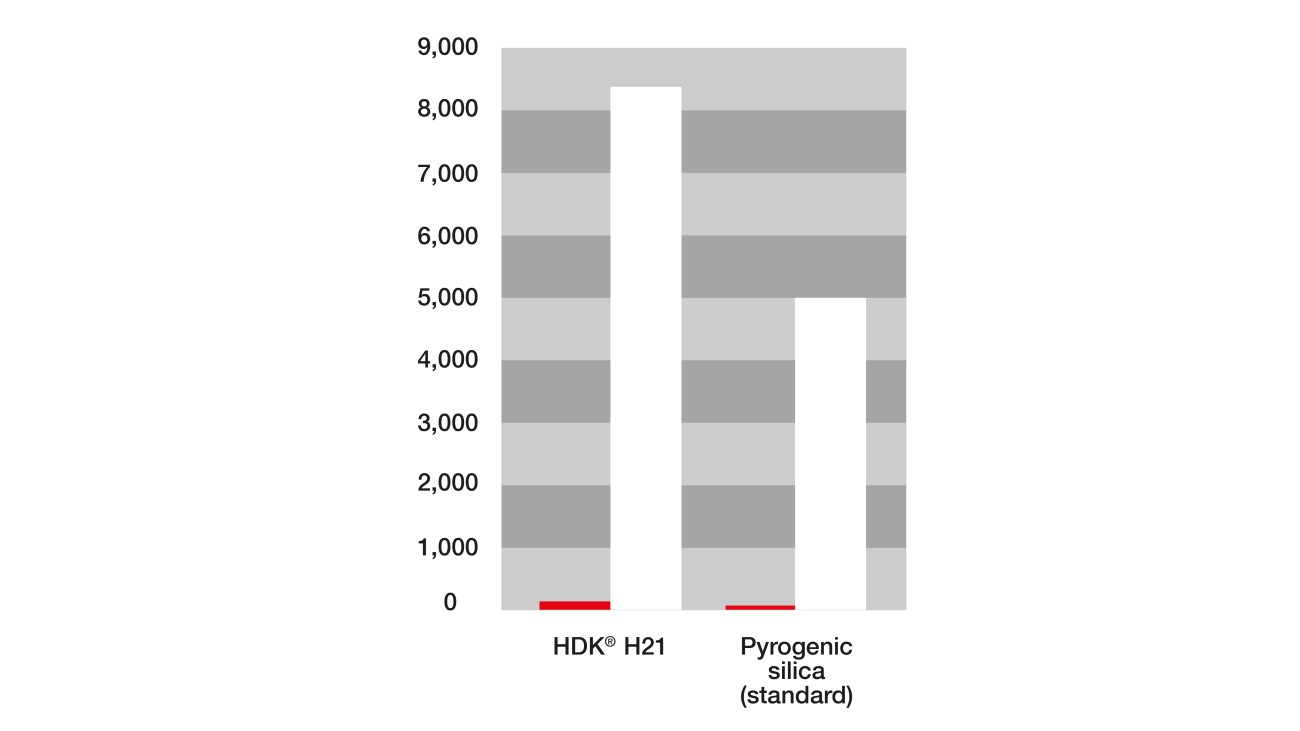
The half-shells of the latest generation of wind turbine are bonded rather than fitted with screw connections.
Mar 01, 2019 Read time: approx. MinutesMinute
HDK® provides sag resistance
In order to apply industrial adhesives in automated processes, manufacturers have to be able to adjust adhesive flow properties precisely. A new pyrogenic silica from WACKER improves not only the viscosity of the adhesives, but also the manufacturing process. Despite its pronounced hydrophobicity, HDK® H21 can be incorporated into liquid adhesives quickly and easily.
Adhesives are what make wind power possible: the rotor blades – as much as 80 meters long in newer on-shore wind turbines – consist of two half-shells bonded firmly together with reinforcement elements, known as shear webs. These adhesive bonds are capable of transmitting the powerful forces that arise during turbine operation. Other industrial sectors are turning to modern high-performance adhesives for their joining technologies as well: the automotive industry bonds a variety of materials together and needs crash-proof bonds. The construction industry is replacing traditional dowels with chemical ones,
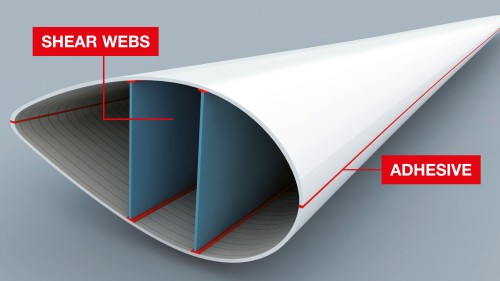
Precise adjustment – when rotor blades are manufactured for wind turbines, an epoxy adhesive is used for bonding the rotor blade half-shells (white) to shear webs (reinforcement elements; blue). This involves applying a thick layer of adhesive to the bonding surfaces (red line). WACKER pyrogenic silicas ensure the sag resistance of the adhesive by allowing producers to precisely adjust the thixotropy of the formulation.
For most structural bonds, industry uses adhesives based on epoxy resins, vinyl ester resins or polyurethanes. When using polar, high-performance adhesives such as those in automated processes, manufacturers introduce rheological additives to modify the flow properties of adhesives as needed, thus ensuring flawless, reproducible application on the bonding surfaces.
HDK® H18, a highly hydrophobic – water-repellent, in other words – pyrogenic silica from WACKER sets the benchmark for rheological effectiveness. The additive’s pronounced hydrophobicity plays a critical role in making it effective. Powerful mixers are required, however, for incorporating and dispersing HDK® H18 silica into polar adhesive formulations within an efficient amount of time.
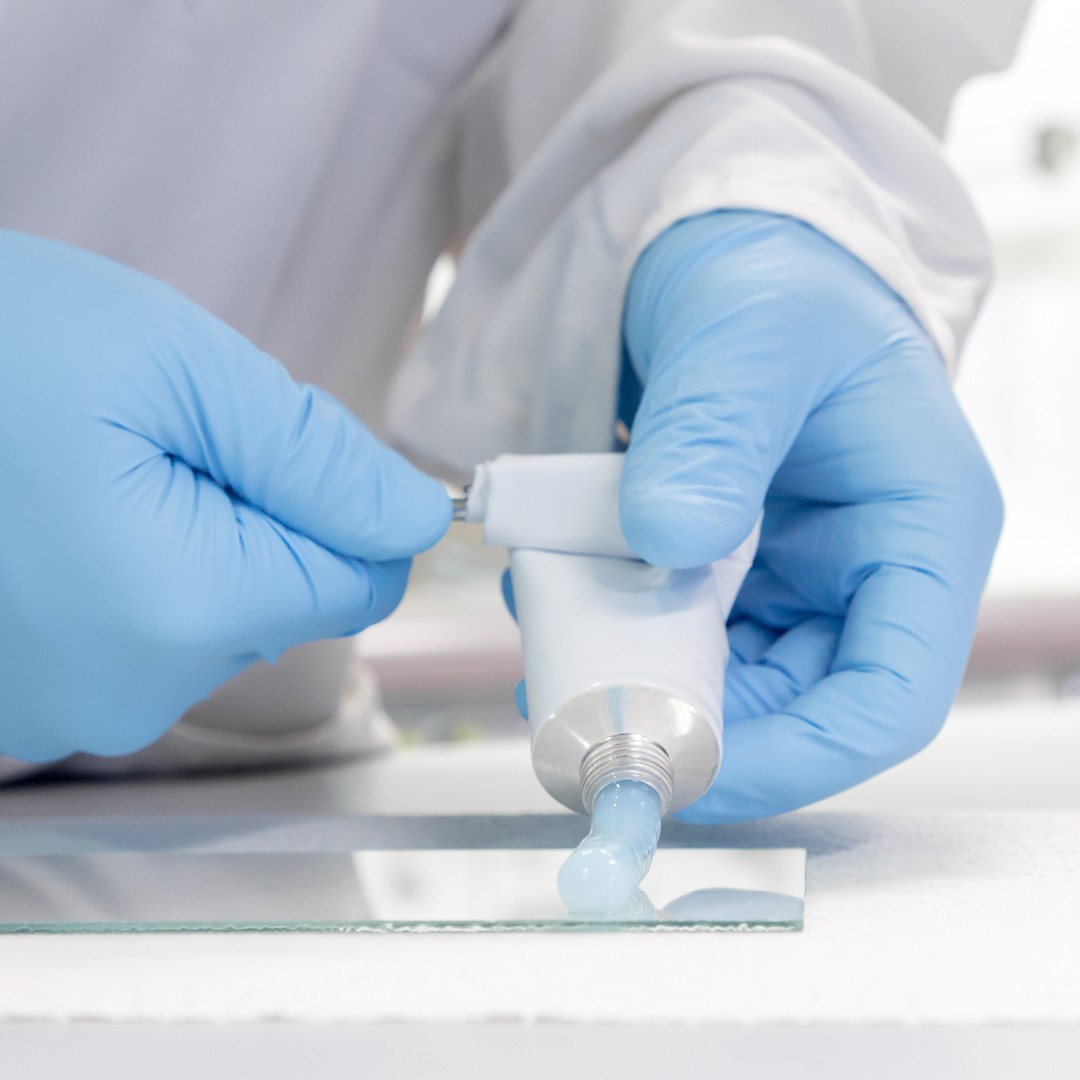
A member of WACKER’s technical support team presses an epoxy resin adhesive onto a pane of glass.
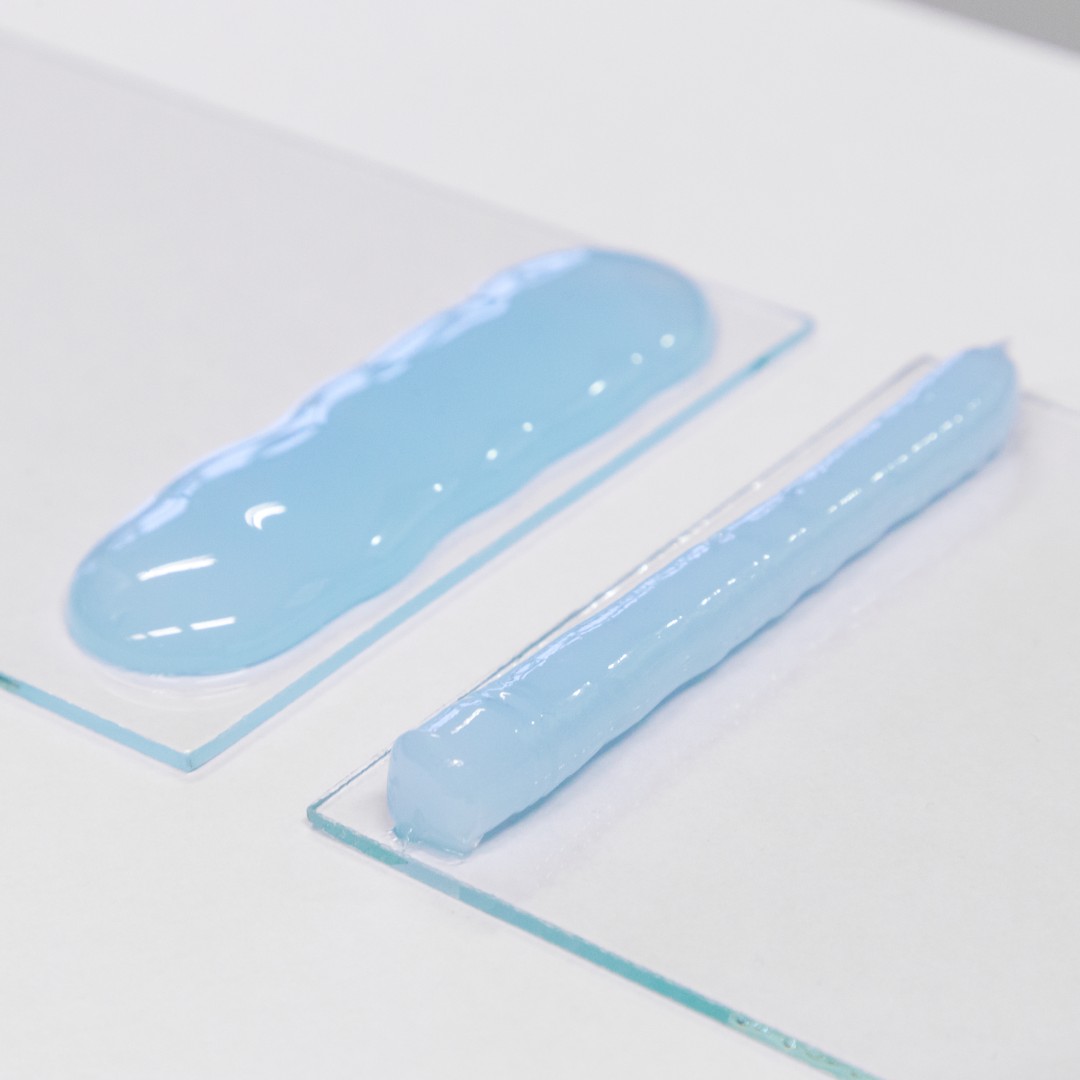
The adhesive sample has been formulated with HDK® H21 and therefore exhibits much better sag resistance – it does not run, unlike its counterpart.
This is where HDK® H21 comes into play, a product that WACKER unveiled to a broad technical audience at this year’s European Coatings Show. “Besides being significantly easier to incorporate into polar liquids, our new product also stands out for its exceptional rheological effectiveness,” explains Anna-Maria Biebl, director of the HDK® EMEA/India business team at WACKER.
The prominent feature of all pyrogenic silicas is their large specific surface area of up to 400 m400/g, which is due to their particle structure: “The smaller the primary particles that make up the aggregate, the larger the resulting particle surface and the denser the network,” explains Dr. Ingmar Piglosiewicz, technical service manager for hydrophobic HDK® at WACKER.
Close-meshed network
A close-meshed network naturally does a better job of withstanding shear forces than a loose, open-pored one, which is why silicas can be used for adjusting the flow properties of liquid products.
The size of the specific surface area is also reflected in a large number of additional product characteristics. HDK® H18 and HDK® H21 are based on particles with large specific surface areas – the area of even just a few grams of these grades is equivalent to that of a soccer field.
Silanol groups, which can be found on the surface of silica particles produced via flame hydrolysis, lend the particles a polar and initially hydrophilic character. The reactivity of these silanol groups makes it possible to modify particles selectively using organosilicon compounds. In processes like this, the surface of the silica is made hydrophobic and non-polar, giving it water-repellent properties and consequently reducing the number of silanol groups available to reactive adhesive systems. Hydrophobizing the surface of the silica guards against reactions with adhesive resins, thus contributing to its shelf life.
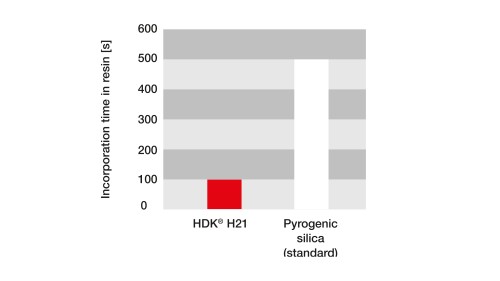
Easy to process – the new HDK® H21 grade of silica can be quickly incorporated into polar adhesive resins. Comparison tests using epoxy resins and a silica concentration of 8% show that HDK® H21 can be incorporated into liquid epoxy resins much more quickly than other products, making this production step more efficient.
Carbon confers hydrophobicity
Hydrophobic HDK® is always produced in a process downstream from flame hydrolysis – by treating it with a polydimethylsiloxane (PDMS), for example, which is how WACKER produces HDK® H21 and HDK® H18. One way to gauge the degree of hydrophobization achieved is to determine the amount of carbon, which is incorporated into the silica by means of the methyl groups on the PDMS. The carbon content of HDK® H21 is roughly 5.5%. “That value is also high for a silica with a large specific surface area, which makes HDK® H21 an especially hydrophobic grade,” Piglosiewicz explains. “That’s an important prerequisite for controlling the flow properties of polar adhesives efficiently.”
Highly hydrophobic and thus non-polar silicas are effective rheological additives for polar adhesive systems. The difference in polarity between hydrophobic, non-polar silica and the polar adhesive system causes the silica aggregates to interact more with each other, and less with the adhesive matrix. The interactions between particles produce stable agglomerate networks that ultimately yield the desired rheological effects.
On the other hand, highly hydrophobic silicas are very difficult to wet with polar adhesive systems, as the difference in polarity generally means that the time needed to incorporate the silica into the adhesive system is significant, requiring appropriate equipment. As a result, the use of hydropobic silicas, while necessary, poses challenges to manufacturers.
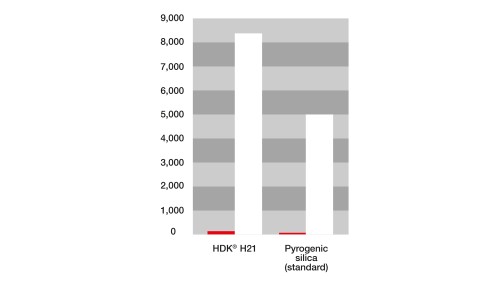
Viscosity of epoxy resin formulations – addition of new HDK® H21 at a concentration of 8% (left two bars) makes a liquid epoxy resin highly viscous at a low shear rate (0.1 s–1, white bar). The resin is thick when stirred slowly. If the shear rate is high, by contrast (10 s–1, red bar), the viscosity drops precipitously, and the resin becomes thin. It follows that the addition of the new, highly hydrophobic silica greatly increases pseudoplastic behavior.
“Our developers have succeeded in significantly influencing the wetting behavior of silica hydrophobized with polydimethylsiloxane and considerably reducing the time it takes to incorporate the silica into polar adhesive systems. That makes the silica easier to handle.”
Maria Biebl, director of the HDK® EMEA/India business team at WACKER
In the corresponding studies, the chemists at Burghausen took a particularly close look at epoxy, isocyanate, polyol and vinyl ester systems.
The formation of silica agglomerate networks in liquids is reversible – shear forces can convert agglomerates to aggregates or to smaller agglomerate units, which then revert to agglomerates when the forces subside. When liquid adhesive systems are in storage, the domains of silica networks increase viscosity, generate a rheological yield point and thus prevent adhesive components such as fillers from settling. Addition of silica, in other words, significantly improves storage stability. Even after the adhesive has been applied on a substrate, the silica networks are capable of resisting the effects of gravity and, by generating a rheological yield point, prevent the adhesive from running.
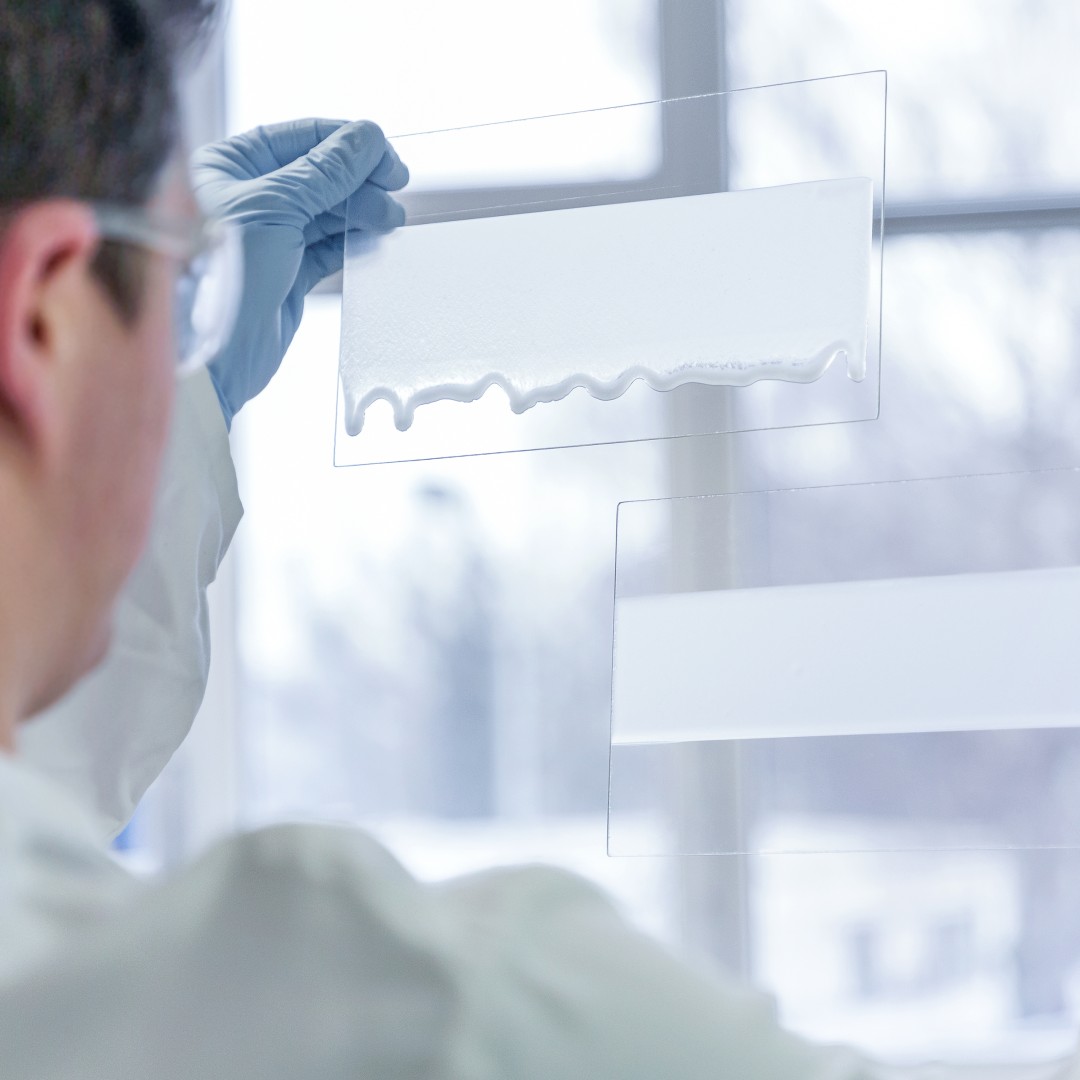
An epoxy resin rendered thixotropic with HDK® H21 is applied to an inclined pane of glass: the polar adhesive component containing HDK® does not run and the layer exhibits sag resistance.
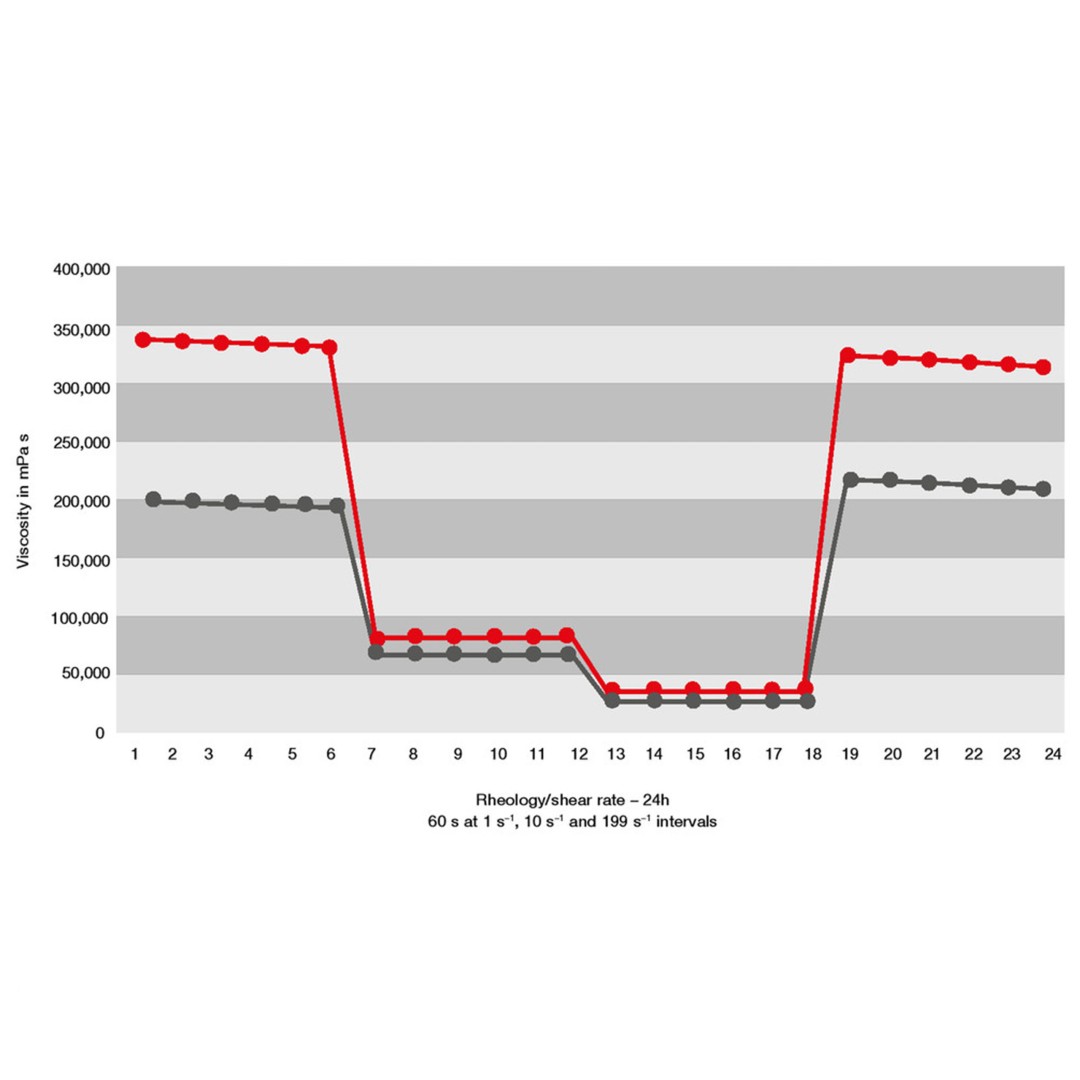
Viscosity and time – the degree to which hydrophobic pyrogenic silicas differ in terms of their rheological efficacy can be seen in these graphs of viscosity vs. time for a vinyl ester resin formulated with silicas. Viscosities were determined at each of the following shear rates: 1 s-1, 10 s–1 and 199 s–1. HDK® H21 (red curve) yields a significantly higher viscosity at low shear and produces a much more pronounced thixotropic effect than a standard hydrophobic silica (gray curve).
Reversible networks
“The use of silica makes it possible to produce formulations that do an exceptionally good job of resisting sag,” observes Piglosiewicz from WACKER Technical Support, summarizing the advantages of the additive. Users want the adhesive to be easy to process too, however, and that, in turn, requires lower viscosities. Shear forces act on the silica system during processing and application (mixing, pumping and extrusion). These forces break down the agglomerate networks, making the viscosity of the liquid formulations sufficiently low relative to their resting state.
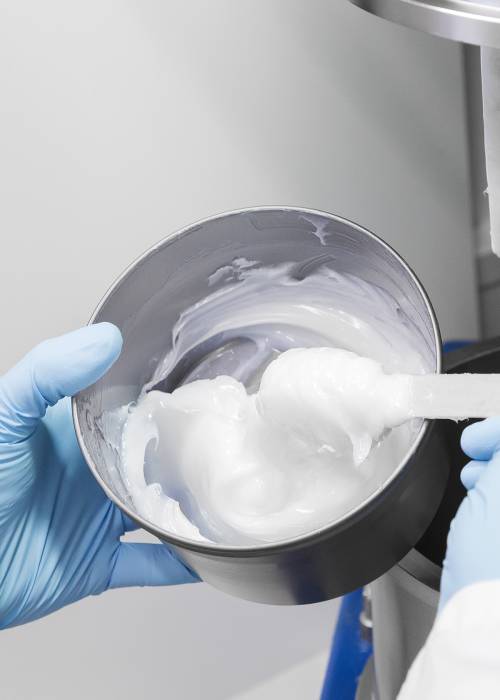
As Piglosiewicz points out, “The formation of reversible silica networks in adhesive systems causes and enables both of these characteristics: high viscosity in liquid formulations at rest and low viscosity during processing and application.” This behavior is referred to as shear thinning or pseudoplasticity, also known as thixotropy.
The thixotropic effect makes for a reliable, flawless bond on inclined mating surfaces, such as those found in certain sections of the half-shells of wind turbines or in automobile bodies – the adhesive does not drip down from the mating surfaces. The effect is similar in chemical dowels, which are used for bonding heavy building elements, a process in which holes are drilled into the weight-bearing component of the building, and anchor bolts are glued into those holes. These bolts, in turn, serve as mounting elements for the component to be attached – a balcony, for instance. When the rheology of the structural adhesive used has been adjusted correctly, no adhesive will run out of the boreholes, so that the bolts always remain firmly anchored in the holes after curing.
Significant differences
If the adhesive needs to be highly thixotropic, the polarity of the liquid phase and of the HDK® will differ significantly. The reason? When major differences in polarity are present, the aggregate particles of HDK® are drawn to form relatively shear-resistant agglomerate networks. The aggregates will then favor interactions with their own kind – and not with the physically different molecules of the liquid phase. This results in significant differences in viscosity between high shear rates, at which no HDK® agglomerate networks exist, and low shear rates, which allow the networks to form. Formulators can precisely calibrate the extent of the rheological effect by varying the amount of HDK® used. Efficiently adjusting the flow properties of a polar industrial adhesive requires a non-polar and thus highly hydrophobic grade such as HDK® H21. “Because HDK® H21 is so rheologically effective, it also helps reduce the concentration of silica in highly polar formulations,” Piglosiewicz explains, noting that this could bring costs down as well.
Pyrogenic silica
Silicon dioxide in highly pure, amorphous form with a large surface area results when chlorosilanes are combusted in an oxyhydrogen flame at temperatures between 1,200 and 1,500 °C. The chemical reaction can be described as chlorosilane hydrolysis. In the hottest portion of the flame, the first compound to form is molecular silicon dioxide. As they move through colder regions, the molecules agglomerate to form spherical liquid particles, or protoparticles. The diameter of these droplets continues to grow as long as they remain liquid. At the end of this phase, they reach some 10 to 50 nanometers in diameter, at which point they are only partly liquid and are then referred to as primary particles.
When primary particles collide, they do not entirely merge to form larger spherical particles – they instead fuse to become highly branched aggregates ranging in size between 100 and 500 nm. At the colder end of the flame, these aggregates solidify completely and assemble into structures held together by hydrogen bridges and reaching sizes of over 1 micrometer. Within these structures, which are known as agglomerates, the aggregate particles develop into a three-dimensional network that is more or less sensitive to shear forces – in other words, it can be broken back down into aggregate particles or smaller agglomerate units. The stability of these networks plays an important role when silicas are used for adjusting the flow properties of liquid products.
Contact
For more information on this topic, please contact:
Mr. Dr. Ingmar Piglosiewicz
Head of HDK® Technical Service
WACKER SILICONES
+49 8677 83-86417
ingmar.piglosiewicz@wacker.com

